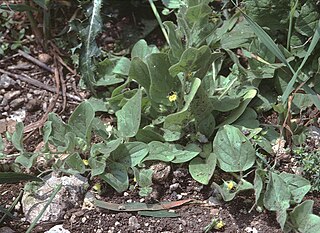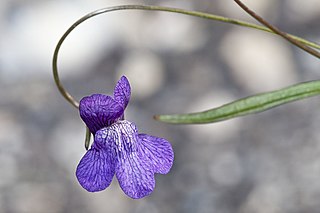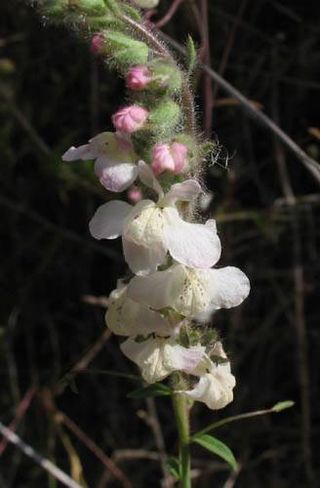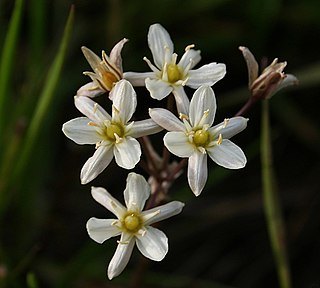
Antirrhinum majus, the common snapdragon, is a species of flowering plant belonging to the genus Antirrhinum. The plant was placed in the family Plantaginaceae following a revision of its prior classical family, Scrophulariaceae.

Coreopsis bigelovii is a species of flowering plant in the daisy or sunflower family, Asteraceae, with the common names Bigelow coreopsis and Bigelow's tickseed. It is endemic to California.

Eulobus californicus, is a species of flowering plant in the evening primrose family known by the common name California suncup. It is native to California, Arizona, and adjacent northwestern Mexico, where it grows in scrub, chaparral, and desert plant communities.

Kickxia elatine is a species of flowering plant in the family Plantaginaceae. It is native to Europe and Asia, but it is present on other continents as an introduced species, and sometimes a noxious weed.

Kickxia spuria is a species of flowering plant in the family Plantaginaceae known by several common names, including roundleaf cancerwort and round-leaved fluellen. It is native to Europe and Asia, but it is present on other continents as an introduced species, and sometimes a noxious weed. This is a low hairy herb with a creeping stem with many branches. It produces rounded, fuzzy leaves at wide intervals along the stem, and solitary snapdragon-like flowers. Each flower is up to 1.5 centimeters long with a narrow, pointed spur extending from the back. The lobes of the mouth are yellow, white, and deep purple, and the whole flower is fuzzy to hairy. The fruit is a spherical capsule about 4 millimeters long. This species is similar to its relative, Kickxia elatine, but for the shape of its leaves, and the hairy flower stalk, which is bare with Kickxia elatine.

Lepidium flavum is a species of flowering plant in the mustard family known by the common name yellow pepperweed. It is native to California, Nevada, and Baja California, where it grows in the Sonoran and Mojave Deserts. The species epithet flavum is Latin for yellow and indicates its flower colour.

Neogaerrhinum strictum, synonyms including Antirrhinum kelloggii and Neogaerrhinum kelloggii, is a species of flowering plant in the family Plantaginaceae. It is known by the common name Kellogg's snapdragon.

Sairocarpus coulterianus is a species of New World snapdragon known by the common name Coulter's snapdragon.

Adenophyllum porophylloides is a species of flowering plant in the family Asteraceae known by the common names San Felipe dogweed and San Felipe dyssodia. It is native to the Sonoran and Mojave Deserts of the southwestern United States and northwestern Mexico.
Pseudorontium is a genus of flowering plants with one species, Pseudorontium cyathiferum, a New World snapdragon known by the common names dog's-mouth and Deep Canyon snapdragon. It is native to the deserts of northern Mexico and adjacent California and Arizona. It is an annual herb producing a hairy, erect, non-climbing stem with many oval-shaped leaves. The solitary flowers are dark-veined deep purple and white, often with some yellow in the throat, and are about a centimeter long. Previously considered to belong among the New World Antirrhinum species, it is now considered the sole member of the related genus Pseudorontium.
Brickellia arguta is a North American species of flowering plant in the family Asteraceae known by the common name pungent brickellbush. It is native to the Mojave and Sonoran Deserts of California, Nevada, Arizona, and Baja California.

Chylismia cardiophylla is a species of evening primrose known by the common name heartleaf suncup. It is native to the deserts of northwestern Mexico and the southwestern United States, where it grows in sandy and rocky areas in the desert scrub. It is an annual or perennial herb approaching one meter in maximum height, taking the form of a single erect stem or a low bushy plant. The leaves are up to about 5 centimeters long and are oval or roughly heart-shaped, with rippling or dully toothed edges. The nodding inflorescence is a dense bunch of flowers, each individual cup-shaped bloom on a stout pedicel. The flowers are yellow or cream-colored with petals 3 to 12 millimeters long, and generally remain closed during the day. The fruit is a capsule 2 to 5 centimeters long.

Eriophyllum mohavense, also known as the Mojave woolly sunflower or the Barstow woolly sunflower, is a rare species of small annual flowering plant in the family Asteraceae, found only (endemic) in the Mojave Desert of California.

Chaenactis glabriuscula, with the common name yellow pincushion, is a species of flowering plant in the daisy family. It is native to California and Baja California.

Eucrypta micrantha is a species of flowering plant in the waterleaf family known by the common name dainty desert hideseed.
Leptosiphon filipes is a species of flowering plant in the phlox family known by the common name thread linanthus.

Muilla maritima is a species of flowering plant known by the common names sea muilla and common muilla. It is native to California and Baja California, where it grows in many types of habitats from the coast to the Mojave Desert and Sierra Nevada foothills and other inland mountains, in grassland, woodland, desert, and forest floras. It is a perennial plant growing from a corm and producing an erect flowering stem up to half a meter tall. The onion-like leaves at the base of the stem may be 60 centimeters long. The flowering stem bears an umbel-shaped array of many flowers on pedicels up to 5 centimeters long. Each flower has six tepals which are green-tinged white in color with brownish midribs and no more than 6 millimeters in length. At the center of the flower are six erect stamens with blue, green, or purplish anthers.
Nemacladus ramosissimus is a species of flowering plant in the bellflower family known by the common name smallflower threadplant. It is native to the mountains and deserts of the southern half of California and adjacent parts of Baja California. It is a small annual herb producing a thread-thin erect brown or purplish stem up to about 32 centimeters tall. Lobed oval leaves under 2 centimeters long occur at the base of the plant. The inflorescence is a series of branches bearing occasional flowers on thin, curving pedicels. There is a single small bract at the base of each pedicel. The flower is no more than 2 millimeters long with five white lobes fused along the lower half.

Nemacladus sigmoideus is a species of flowering plant in the bellflower family known by the common name sigmoid threadplant. It is native to the mountains and deserts around the intersection of California, Nevada, Arizona, and Baja California. It is a small annual herb producing a thin, spreading purplish or brown stem no more than 12 centimeters long. Hairy, sometimes toothed oval leaves up to a centimeter long occur at the base of the plant. The inflorescence is a series of zigzagging branches bearing flowers on thin pedicels which are sigmoid in shape. There is a single tiny bract at the base of each pedicel. The hairy flower is under 4 millimeters long. It has five yellow-tipped white lobes.

Physaria kingii is a species of flowering plant in the family Brassicaceae known by the common name King bladderpod. It is native to western North America from Utah to Baja California, where it grows in dry and rocky habitat, such as deserts and adjacent mountain slopes. This is a perennial herb growing a small, hairy stem from a caudex. The leaves form a patch or rosette around the caudex, each up to 6 centimeters long and round, oval, diamond, or spoonlike in shape. The inflorescence is an erect or mostly upright raceme of bright yellow mustardlike flowers. The fruit is a hairy capsule under a centimeter long suspended on a short, often curvy pedicel.
















